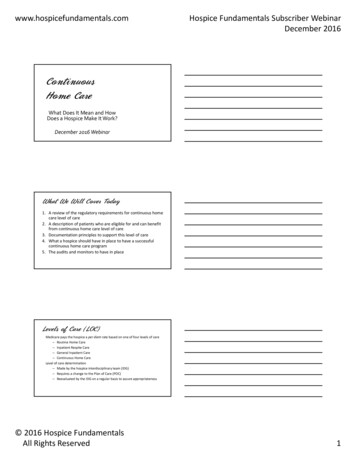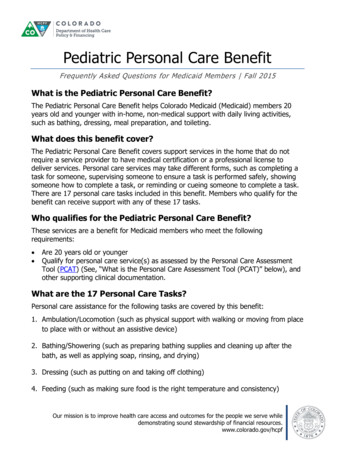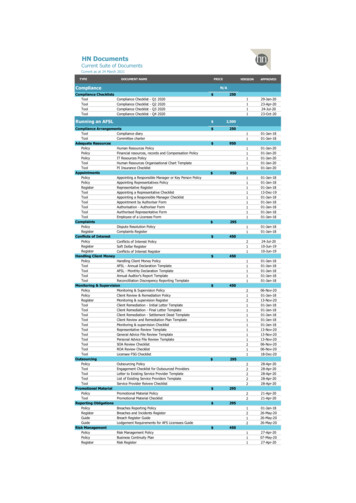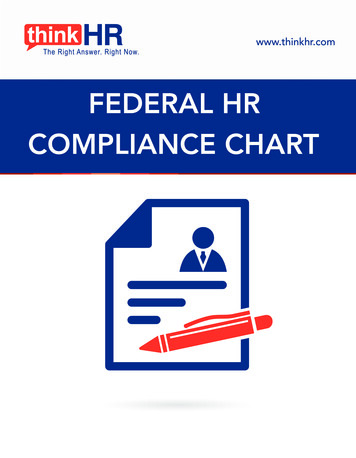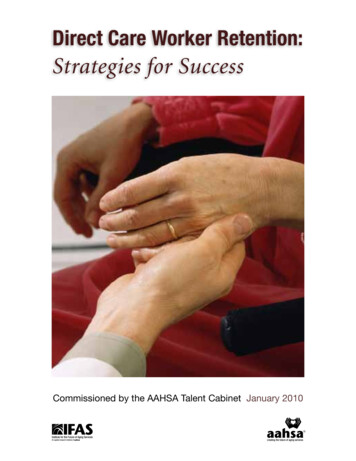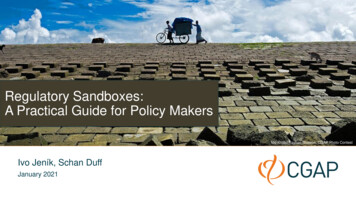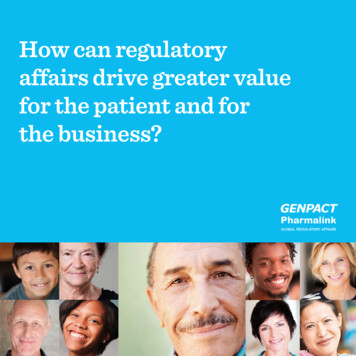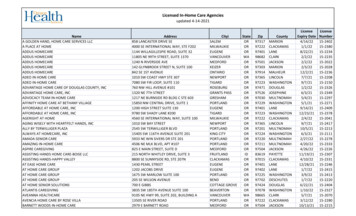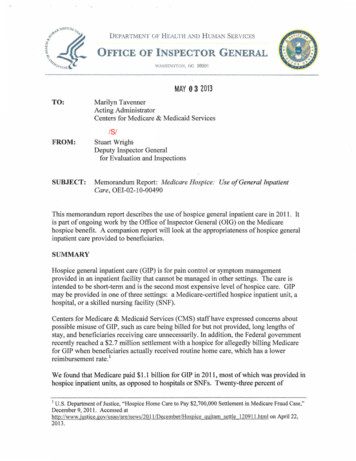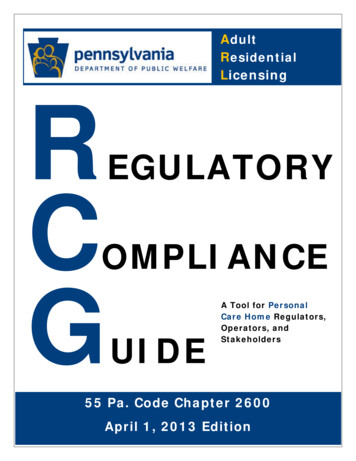
Transcription
RCGAdultResidentialLicensingAdult Residential LicensingEGULATORYOMPLIANCEUIDEA Tool for PersonalCare Home Regulators,Operators, andStakeholders55 Pa. Code Chapter 2600April 1, 2013 Edition1
IntroductionWhat is this guide, and why do I need it?On October 25, 2005, 55 Pa.Code Ch. 2600 (relating to personal care homes) becameeffective. These regulations govern the operation of personal care homes in the Commonwealthof Pennsylvania. In most cases, the regulations speak for themselves. There are, however,some regulations that require additional clarification. Even when the meaning of a regulation isvery clear, the purpose and intent of the regulation may not be. There are also different ways tomeasure regulatory compliance, and both operators and inspectors need to know howcompliance will be determined. This guide is meant to help operators and inspectors betterunderstand the regulations.This guide is a companion piece to 55 Pa.Code Ch. 2600; it should be used along with theregulations, not instead of them. The explanatory material in this guide is not meant to be “newregulations” or to extend meaning of the regulations beyond their original intent.Between October 2005 and October 2010, the Department of Public Welfare (Department)issued a document known as the Licensing Measurement Instrument, or LMI. The LMI providedexplanations of the regulations, application instructions for Departmental licensing staff,background information and intent of the regulations, and selected recommendations toencourage the adoption of higher standards. Over that five-year period, much has been learnedabout the application of the regulations in personal care homes. That understanding has lead tothe creation of this guide. This guide replaces the August 28, 2008 LMI, and any regulatoryclarifications issued between August 2008 and December 31, 2010.This guide has been developed to provide clearer explanations of the regulatory requirementsof 55 Pa. Code Chapter 2600 to help personal care home operators provide safe environmentsand effective services to residents through regulatory compliance, and to help regulators protectresidents by conducting consistent and comprehensive inspections. It provides a detailedexplanation of each regulatory requirement, including expectations for compliance, guidelines formeasuring compliance, and the primary purpose for the requirement. In addition, this guideincludes general regulatory requirements and procedures, a glossary of regulatory terms,overviews of complex regulatory issues to provide a more global understanding of the chapterand its purpose.2
How to Use the Regulatory Compliance GuideEach regulation that can be measured during an inspection is included in the RCG and isaccompanied by clarifying information. The illustration below shows how regulations arepresented, and how inspectors and homes can effectively use the RCG.This area lists the regulation exactlyas it appears in Chapter 2600.The “Discussion” section providesinformation about applying theregulation, including referencing otherregulations and applicable narratives.The “Inspection Procedures” sectiondescribes how inspectors maymeasure compliance with theregulation.The “Primary Benefit” sectionexplains how the regulation protectsresidents’ health, safety, and wellbeing.16f2600.16(f) - The home shall keep a copy of thereport of the reportable incident or condition.Discussion: Copies of all reports must be retained.Retention of the incidents in residents’ records is inaccordance with § 2600.252(10), but remember thatreportable incidents must be reviewed in aggregate as partof the home’s quality management process pursuant to§ 2600.26(b)(1).Inspection Procedures: Inspectors will verify that copiesare retained. If necessary, inspectors will compare thehome’s record of reports with those received by the regionaloffice.Primary Benefit: Permits homes to review reports toidentify and address patterns of incidents and conditions thatmay otherwise be a source of harm to residents.“Recommended”Throughout the RCG, you will repeatedly see the words “recommended” or “stronglyrecommended.” These words indicate that the what you are reading is a suggestion based onbest practices, not a regulatory requirement. Failure to follow a recommendation will not resultin a regulatory violation.Transitioning from LMI to RCGAdult Residential Licensing understands that there will be a “transition period” as homesconvert from the application of LMI to RCG. Given the less-proscriptive nature of the RCG, it isnot anticipated that the conversion will be an undue hardship. Nevertheless, inspectors willconsider transition-related areas of noncompliance when applying the RCG for the first sixmonths of implementation such that homes are not subjected to unreasonable expectations. Asthe first edition of the RCG was dated January 1, 2012, the “transition period” from theapplication of the LMI to the RCG will conclude on June 30, 2012.3
“Admission Date” Versus “Move-In Date”Multiple regulations (including but not limited to regulations relating to resident-homecontracts, medical evaluations, assessments, and support plans) require certain events to occurbefore, after, or on the date of admission. Homes occasionally use the term “admission” to referthe date a contract is signed, the date an admission fee is paid, or the date a resident movespersonal items such as furniture into the home. The Department interprets “admission date” tomean the first day the resident resides in the home. As such, the date the resident begins tolive at the home is the date from which regulatory timeframes relating to admission should bemet.Grace Periods“Annually” as used throughout this instrument means at least once every 12 months. A 15day flex or grace period is allowed for any item that has a time requirement of one year or more.This includes, but is not limited to: Medical evaluations (§ 2600.141) Fire-safety inspections and supervised fire drills (§ 2600.132(b)) Documentation of evacuation times and fire-safe areas (§ 2600.132(d)) Completion of ANNUAL Resident Assessments (§ 2600.225(c)(1)))Unless there is a specific grace period or timeline specified in the applicable section, a 5-dayflex or grace period is allowed for any item that has a time line of less than one year. This doesnot apply to the following: Inspecting fire extinguishers (§ 2600.131(f)) Conducting fire drills (§ 2600.132(a))The grace period on timelines does NOT apply to the following regulations: § 2600.25(a) § 2600.25(e) § 2600.51-52 § 2600.224(a) § 2600.231(c)Indicator SystemIn some cases, a personal care home will receive a shorter inspection in place of the fullinspection. The Licensing Indicator System is a shortened version of the inspection process thatmeasures compliance with a small number of regulations that predicts compliance with all theregulations. If a home is in complete compliance with all the regulations measured in theLicensing Indicator System, high compliance with all the regulations is predicted.The purpose of the Licensing Indicator System is to refocus the emphasis of the licensingprocess. Through the use of the Licensing Indicator System, less time is spent conducting fullinspections in homes with a history of high regulatory compliance and more time is spent a)providing technical assistance to homes with a history of low regulatory compliance and b)conducting more in-depth inspections in homes with a history of low regulatory compliance.Use of this new system does not mean that a home no longer needs to meet all theregulations (55 Pa.Code Ch. 2600 relating to personal care homes). Full compliance with allregulations continues to be required. It is critical that a home does not focus on compliance with4
only the indicator regulations, but rather continue to develop comprehensive operational,staffing, and management systems to comply with all regulations in a systemic and interrelatedmanner.A full inspection must be conducted every three years. Use of the indicator system will not beannounced to the operator in advance of the inspection.Inspection ProceduresPlease note that the “inspection procedures” are guidelines, and the specific means of measuringcompliance with a regulation may differ depending on circumstances specific to the home andthe nature of the regulatory violation.5
PART 1:Regulations,Discussion,and InspectionProcedures6
INDEX OF REGULATIONS BY TOPICTo learn more about a particular topic, please review the applicable regulations.Regulations and regulatory clarifications are listed on the following pages in numericalorder as they appear in 55 Pa.Code Ch. 2600.TOPICAPPLICABLE REGULATIONSAbuse Reporting15a-dAccess to Home by DPW, AAA, etc.5a1-4, 5bPersonal Care Needs23a-bActivities221a-cActivity Space98-99Administrator Qualifications53 a-hAdministrator Staffing56Administrator ms101a-rBlocked Exits121-123Certificate of Occupancy / Fire Safety Approval14a-dCommunications/Phone90-91Community Services222Complaints made by Residents or Family44a-gCriminal History Checks51-52Dining Room104a-eDirect Care Staff Qualifications54a-cDirect Care Staffing57-62Direct Care Training65a-iElevators97Emergency Medical Plan143a-bEmergency Preparedness107a-dExit Signs133Exterior100a-bFinancial Management for Residents20a, 20b1-10Fire Drills132a-jFire Extinguishers131a-fFire Official Notice124First Aid Kit96a-c7
TOPICAPPLICABLE REGULATIONSFirst Aid/CPR Training63Flammable Material125a-bFood service103a-jFurniture95Heat Sources126-129Hospice Services29Laundry105a-gMaximum Capacity13bMedical Evaluations141a-bMedications - Administration181-182Medications - Errors/Reactions188-189Medications - Labeling184a-cMedications - Prescriptions186a-cMedications - Records187a-dMedications - Resident Education191Medications - Storage183a-gMedications - Training190a-cNutrition/Meals161-164Other Laws and Regulations11a, 18Outings and Offsite Services21Personal Hygiene24Pets109a-dPosting License and VR3cQuality Management26a-cRecord Confidentiality17Refunds28a-gReportable Incidents16b-fResident Records224-227Resident Records - Access254a-cResident Records - Content252Resident Records - Requirements251a-eResident Records - Retention253a-dResident Rights - Deprivation Prohibited43a-bResident Rights - List of Rights42a-yResident Rights - Notification41a-eResident-Home Contract25a1-2, 25b, 25c1-13, 25d-hRestraints and Safe Management Techniques201-2028
TOPICAPPLICABLE REGULATIONSSanitation, Surfaces, and Equipment81-88Secured Dementia Care Units - Admission231a-hSecured Dementia Care Units - Discharge235Secured Dementia Care Units - DPW Notice239Secured Dementia Care Units - Locks/Alarms233Secured Dementia Care Units - Physical Environment232a-dSecured Dementia Care Units - Program237a-bSecured Dementia Care Units - Resident Care234a-eSecured Dementia Care Units - Staff Training236Securing Health Care142a-dService Description223a-bService Termination228a-hSmoke Detectors130a-iSSI Recipients27a-eSwimming Areas106Tobacco144a-dTraining apons108Windows/Passages92-949
GENERAL PROVISIONSInspections and Licenses3c2600.3(c) - The personal care home shall post the current license, a copy of the current licensinginspection summary issued by the Department and a copy of this chapter in a conspicuous andpublic place in the personal care home.Discussion: A “licensing inspection summary” is the Violation Report (VR) with a plan of correction approved bythe Department. The Department interprets ‘most current version’ to mean: The VR that was issued with the most current license, and Any additional VRs issued between the most current license and the receipt of the next license.If there is no VR since there are no violations, the VR does not need to be posted. A “copy of this chapter” meansthe “pink book,” 55 Pa.Code § 2600.These items must be displayed in a public area of the home, such as a public bulletin board in the home’s entryway,in a manner easily visible and accessible to all residents and visitors.Inspection Procedures: Inspectors will view the area where the required items are posted to determine if theyare accessible to all residents and guests without assistance from staff.Primary Benefit: Permits residents, families, and visitors to learn about applicable regulations and the regulatorycompliance status of the home and the home’s plan to correct any violations found.Access5a12600.5(a)(1) - The administrator or a designee shall provide, upon request, immediate access tothe home, the residents and records to: Agents of the Department.Discussion: An agent of the Department is any individual authorized by the Department to enter, visit, inspect, orinvestigate regulatory issues in personal care homes. In the case of access to residents who are not currently atthe home, access should be granted as soon the resident can return to the home. Access must be provided to allareas of any building accessible to residents and to areas where harmful materials may be stored.Resident records must be kept on site; other records may be kept off-site as long as such storage permitsimmediate access regardless of the day or time of the request.Inspection Procedures: “Immediate” means a reasonable period of time depending on the request. Forexample, it’s reasonable to expect a home to produce a resident’s support plan within 10 minutes during regularbusiness hours, but unreasonable to expect off-site staff records to be delivered within 10 minutes at 2:00 AM.Primary Benefit: Allows the Department to measure compliance with all regulations.5a22600.5(a)(2) - The administrator or a designee shall provide, upon request, immediate access tothe home, the residents and records to: Representatives of the area agency on aging.Discussion: A representative of the area agency on aging is any individual authorized by the area agency on agingto enter, investigate, or provide services in personal care homes. In the case of access to residents who are notcurrently at the home, access should be granted as soon the resident can return to the home. Access must beprovided to all areas of any building accessible to residents and to areas where harmful materials may be stored.Resident records must be kept on site; other records may be kept off-site as long as such storage permitsimmediate access regardless of the day or time of the request.Inspection Procedures: “Immediate” means a reasonable period of time depending on the request. Forexample, it’s reasonable to expect a home to produce a resident’s support plan within 10 minutes during regularbusiness hours, but unreasonable to expect off-site staff records to be delivered within 10 minutes at 2:00 AM.Primary Benefit: Allows area agency on aging the ability to fulfill their legal mandate to protect older adults.10
5a32600.5(a)(3) - The administrator or a designee shall provide, upon request, immediate access tothe home, the residents and records to: Representatives of the Long-Term Care OmbudsmanProgram.Discussion: A representative of the Long-Term Care Ombudsman Program is any individual authorized by theLong-Term Care Ombudsman Program to enter, investigate, or provide services in personal care homes. In thecase of access to residents who are not currently at the home, access should be granted as soon the resident canreturn to the home. Access must be provided to all areas of any building accessible to residents and to areas whereharmful materials may be stored.Resident records must be kept on site; other records may be kept off-site as long as such storage permitsimmediate access regardless of the day or time of the request.Inspection Procedures: “Immediate” means a reasonable period of time depending on the request. Forexample, it’s reasonable to expect a home to produce a resident’s support plan within 10 minutes during regularbusiness hours, but unreasonable to expect off-site staff records to be delivered within 10 minutes at 2:00 AM.Primary Benefit: Provides ombudsmen with the access necessary to promote and protect resident rights.5a42600.5(a)(4) - The administrator or a designee shall provide, upon request, immediate access tothe home, the residents and records to: Representatives of the protection and advocacy system forindividuals with disabilities designated under the Protection and Advocacy for Individual RightsProgram of the Vocational Rehabilitation and Rehabilitation Services Act (29 U.S.C.A. § 794e), theProtection and Advocacy for Individuals with Mental Illness Act (42 U.S.C.A. § 10801-10851), andthe Developmental Disabilities Assistance and Bill of rights Act (42 U.S.C.A. § 15041-15043).Discussion: A representative of the protection and advocacy system for individuals with disabilities program is anyindividual authorized by the program to enter, investigate, or provide services in personal care homes. InPennsylvania, this system is currently administered by the Disability Rights Network of Pennsylvania, 1414 CameronStreet, Harrisburg, Pennsylvania 17103-1049, telephone number (717) 236-8110. In the case of access toresidents who are not currently at the home access should be granted as soon the resident can return to the home.Access must be provided to all areas of any building accessible to residents and to areas where harmful materialsmay be stored.Resident records must be kept on site; other records may be kept off-site as long as such storage permitsimmediate access regardless of the day or time of the request.Inspection Procedures: “Immediate” means a reasonable period of time depending on the request. Forexample, it’s reasonable to expect a home to produce a resident’s support plan within 10 minutes during regularbusiness hours, but unreasonable to expect off-site staff records to be delivered within 10 minutes at 2:00 AM.Primary Benefit: Provides advocates with the access necessary to protect the rights of residents with disabilities.5b2600.5(b) - The administrator or a designee shall permit community service organizations andrepresentatives of community legal services programs to have access to the home during visitationhours or by appointment for the purpose of assisting or informing the residents of the availability ofservices and assistance. A resident or a resident’s designated person may decline the services ofthe community service organization or the community legal service program.Discussion: This requirement is closely related to § 2600.222, which requires homes to encourage residents touse social and community services available in the community.Inspection Procedures: Inspectors will interview the administrator, staff of the home, and representatives ofcommunity service organizations who may be present at the home or who file complaints with the Department.Primary Benefit: Allows service organizations to provide information to residents who may benefits from theirservices, and allows the home to ensure compliance with § 2600.222.11
GENERAL REQUIREMENTSProcedural Requirements for Licensure or Approval of Personal Care Homes11a2600.11(a) - Except for § 20.32 (relating to announced inspections), the requirements in Chapter20 (relating to licensure or approval of facilities and agencies) apply to personal care homes.Discussion: Personal care homes are licensed in accordance with the licensing procedures established by 55Pa.Code Chapter 20. Homes are strongly encouraged to review Chapter 20, which is available on the Department’swebsite. Knowledge of Chapter 20 is required by regulation for administrators – see § 2600.53(f).Inspection Procedures: If a violation of Chapter 20 is suspected, inspectors will cite only in consultation with theregional director and ARL headquarters.Primary Benefit: Chapter 20 contains additional regulatory requirements, including the allowable reasons fordenial, revocation, or nonrenewal of a license.Maximum Capacity13b2600.13(b) - The maximum capacity specified on the license may not be exceeded.Discussion: “Maximum capacity” means the total number of residents who require personal care services that thehome is permitted to serve. The maximum capacity is different from the number of people who may reside in ahome as determined by the home’s certificate of occupancy. See “Certificates of Occupancy and MaximumCapacity” in the “Regulatory Issues and Frequently-Occurring Situations” section for more information. Occupantsof the home who do not need personal care services (sometimes referred to as “independent” residents) are notcounted when determining if the home’s maximum capacity has been exceeded. However, because maximumcapacity is determined in part by square footage and by the number of sinks, toilets, and showers in the home, thetotal number of persons living in a home must be considered when determining compliance with other regulations(such as bedroom square footage, number of toilets, and the like).Inspection Procedures: Inspectors will verify the total number of persons who reside in the home. If thenumber of residents who require personal care services exceeds the maximum capacity as specified on the license,a violation exists.Primary Benefit: Protects from overcrowding, and ensures that the number of people living in the home does notexceed toilet, bathing or hand-washing facilities necessary to maintain sanitary conditions.Fire Safety Approval14a2600.14(a) - Prior to issuance of a license, a written fire safety approval from the Department ofLabor and Industry, the Department of Health or the appropriate local building authority under thePennsylvania Construction Code Act (35 P.S. § 7210.101 – 7210.1103) is required.Discussion: Please see “Certificates of Occupancy and Maximum Capacity” in the “Regulatory Issues andFrequently-Occurring Situations” section for more information.Inspection Procedures: Inspectors will review and obtain a copy of the home’s certificate of occupancy duringthe inspection.Primary Benefit: Ensures that the home is appropriately constructed to serve individuals in a residential setting.12
14b2600.14(b) - If the fire safety approval is withdrawn or restricted, the home shall notify theDepartment orally immediately, and in writing, within 48 hours of the withdrawal or restriction.Discussion: A certificate of occupancy may be withdrawn or restricted due to damage, physical site modificationsnot approved by the local building authority, and the like. Withdrawal or restriction will be issued in writing; thiswritten documentation should be provided to the Department with the notification required by this regulation.Inspection Procedures: Inspectors will interview administrator and maintenance staff to determine if the home’scertificate of occupancy has been withdrawn or restricted within the past year or if it is currently restricted.Primary Benefit: Ensures that resident health and safety is not compromised by failure to meet or maintainconstruction standards.14c2600.14(c) - If a building is structurally renovated or altered after the initial fire safety approval isissued, the home shall submit the new fire safety approval, or written certification that a new firesafety approval is not required, from the appropriate fire safety authority. This documentation shallbe submitted to the Department within 15 days of the completion of the renovation or alteration.Discussion: The Uniform Construction Code (UCC) requires a new certificate of occupancy for major structural,electrical, mechanical, and plumbing changes. In the event that a new certificate of occupancy is not required, it isrecommended that a statement from the local building authority or the Department of Labor and Industry indicatingthat a new certificate of occupancy is not required be obtained. Please see “Certificates of Occupancy andMaximum Capacity” in the “Regulatory Issues and Frequently-Occurring Situations” section for more informationabout “major” and “minor” repairs.Inspection Procedures: Minor repairs of most systems do not require new permits. However, major repairs orrenovations may. Inspectors will ask for a new permit or written certification that a new permit is not needed whenmajor repairs, renovations, or new construction has occurred.Primary Benefit: Ensures that resident health and safety is not compromised by failure to meet or maintainconstruction standards.Abuse Reporting Covered by Law15a2600.15(a) - The home shall immediately report suspected abuse of a resident served in the homein accordance with the Older Adults Protective Services Act (35 P.S. Sections 10225.701 –10225.707) and 6 Pa. Code Sections 15.21 – 15.27 (relating to reporting suspected abuse) andcomply with the requirements regarding restrictions on staff persons.Discussion: Please see “Abuse and Abuse Reporting” in “Regulatory Issues and Frequently-Occurring Situations”for more information.Inspection Procedures: Inspectors will verify that the home followed all of the steps as described in the “Abuseand Abuse Reporting” section.Primary Benefit: Ensures that abuse or suspected abuse is appropriately reported and investigated.13
15b2600.15(b) - If there is an allegation of abuse of a resident involving a home’s staff person, thehome shall immediately develop and implement a plan of supervision or suspend the staff personinvolved in the alleged incident.Discussion: Please see “Abuse and Abuse Reporting” in “Regulatory Issues and Frequently-Occurring Situations”for more information.Inspection Procedures:See § 2600.15(a).Primary Benefit: See § 2600.15(a).15c2600.15(c) - The home shall immediately submit to the Department’s personal care home regionaloffice a plan of supervision or notice of suspension of the affected staff person.Discussion: Please see “Abuse and Abuse Reporting” in “Regulatory Issues and Frequently-Occurring Situations”for more information.Inspection Procedures:See § 2600.15(a).Primary Benefit: See § 2600.15(a).15d2600.15(d) - The home shall immediately notify the resident and the resident’s designated personof a report of suspected abuse or neglect involving the resident.Discussion: Please see “Abuse and Abuse Reporting” in “Regulatory Issues and Frequently-Occurring Situations”for more information.Inspection Procedures:See § 2600.15(a).Primary Benefit: See § 2600.15(a).Reportable Incidents and Conditions16b2600.16(b) - The home shall develop and implement written policies and procedures on theprevention, reporting, notification, investigation and management of reportable incidents andconditions.Discussion: There is no requirement for the content of these policies and procedures beyond what is explained indetail below in § 2600.16(c)-(f). However, it is recommended that homes include the following information: Prevention – How will the home identify and keep each type of incident from happening?o Prevention methods will vary by incident type (such as a utility shut-off notice versus a fire); it isrecommended that prevention policies are developed for each type of incident. Prevention policiesfor incidents with similar prevention methods may be combined. Reporting - How will incidents be reported to the administrator? Notification - Who is responsible for notification to the Department and applicable agencies, and what is themethod by which they will make the notification (fax, phone; etc.)? Investigation – What is the method and who is the person responsible for investigating the incident? Management – How will the reportable incident be recorded and stored, and how trends will be tracked?Please see Appendix A for a list of reportable incidents and events that homes are not required to report.Inspection Procedures: Inspectors will review the policies and procedures to verify that all of the contentrequired by this regulation is addressed. If a violation of § 2600.16(c) is identified, inspectors will compare theviolation with the home’s written policies to determine whether the policy was followed and/or if a modification tothe process is required.Primary Benefit: Robust policies and procedures ensures that the home is accurately managing reportableincidents, tracking patterns of incidents, and taking steps to prevent future incidents.14
16c2600.16(c) - The home shall report the incident or condition to the Department’s personal carehome regional office or the personal care home complaint hotline within 24 hours in a mannerdesignated by the Department. Abuse reporting shall also follow the guidelines in § 2600.15(relating to abuse reporting covered by law).Discussion: When it comes to reportable incidents, the more specific information a home can provide about theincident, including a timeline of events, actions taken by the home in response to the event, and the home’s plansto prevent similar incidents in the future, demonstrates the home’s commitment to regulatory compliance and mayreduce the need for the Department to pursue additional information. Please see Appendix A for a list of reportableincidents.Homes should never downplay or minimize the details in an incident report. There have been instances whereincidents with scant details proved to be quite serious, which may suggest a deliberate attempt to withholdinformation – which is usually not the case!Homes frequently ask whether a certain type of event or specific situation needs to be reported. It is recommendedthat homes follow the “when in doubt, send it out” rule: if you have to ask, you should probably send the report.There is no violation for reporting incidents or conditions beyond what is required. However, some events onlyneed to be reported if certain conditions apply: Personal care homes are required to report any “serious bodily injury or trauma requiring treatment at ahospital or medical facility.” The Department interprets “serious bodily injury or trauma” to mean anyinjury where the resident experienced one or more of the following:Substa
2600.3(c) - The personal care home shall post the current license, a copy of the current licensing inspection summary issued by the Department and a copy of this chapter in a conspicuous and public place in the personal care home. Discussion: A “licensing inspection summary” is the Vi

